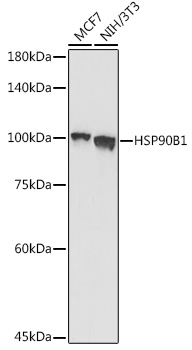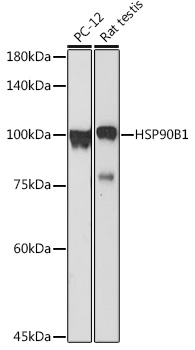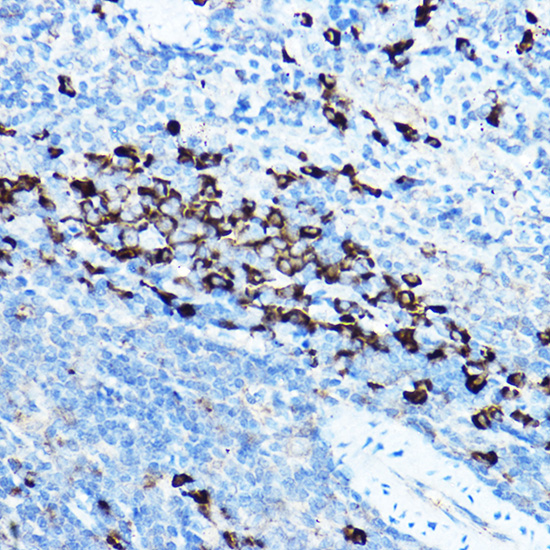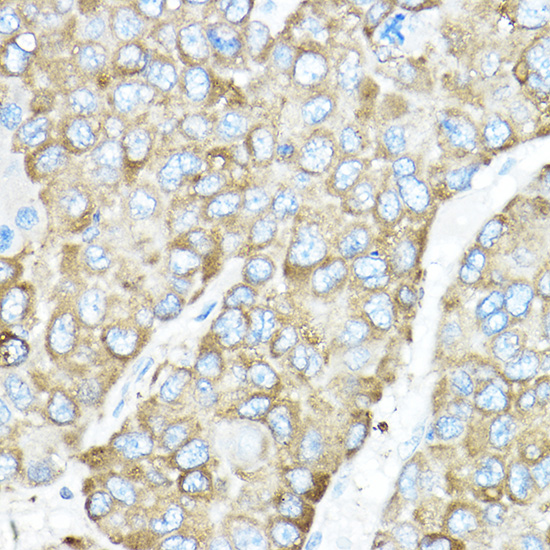Cell Biology Antibodies 10
Anti-HSP90B1 Antibody (CAB6272)
- SKU:
- CAB6272
- Product Type:
- Antibody
- Reactivity:
- Human
- Reactivity:
- Mouse
- Reactivity:
- Rat
- Host Species:
- Rabbit
- Isotype:
- IgG
- Antibody Type:
- Polyclonal Antibody
- Research Area:
- Cell Biology
Description
| Antibody Name: | Anti-HSP90B1 Antibody |
| Antibody SKU: | CAB6272 |
| Antibody Size: | 20uL, 50uL, 100uL |
| Application: | WB IHC IF |
| Reactivity: | Human, Mouse, Rat |
| Host Species: | Rabbit |
| Immunogen: | A synthetic peptide corresponding to a sequence within amino acids 550-650 of human HSP90B1 (NP_003290.1). |
| Application: | WB IHC IF |
| Recommended Dilution: | WB 1:500 - 1:2000 IHC 1:50 - 1:200 IF 1:50 - 1:200 |
| Reactivity: | Human, Mouse, Rat |
| Positive Samples: | MCF7, NIH/3T3, PC-12, Rat testis |
| Immunogen: | A synthetic peptide corresponding to a sequence within amino acids 550-650 of human HSP90B1 (NP_003290.1). |
| Purification Method: | Affinity purification |
| Storage Buffer: | Store at -20'C. Avoid freeze / thaw cycles. Buffer: PBS with 0.02% sodium azide, 50% glycerol, pH7.3. |
| Isotype: | IgG |
| Sequence: | ESSP FVER LLKK GYEV IYLT EPVD EYCI QALP EFDG KRFQ NVAK EGVK FDES EKTK ESRE AVEK EFEP LLNW MKDK ALKD KIEK AVVS QRLT ESPC ALVA S |
| Gene ID: | 7184 |
| Uniprot: | P14625 |
| Cellular Location: | Endoplasmic reticulum lumen, Melanosome |
| Calculated MW: | 92kDa |
| Observed MW: | 100KDa |
| Synonyms: | HSP90B1, ECGP, GP96, GRP94, HEL-S-125m, HEL35, TRA1 |
| Background: | This gene encodes a member of a family of adenosine triphosphate(ATP)-metabolizing molecular chaperones with roles in stabilizing and folding other proteins. The encoded protein is localized to melanosomes and the endoplasmic reticulum. Expression of this protein is associated with a variety of pathogenic states, including tumor formation. There is a microRNA gene located within the 5' exon of this gene. There are pseudogenes for this gene on chromosomes 1 and 15. |
| UniProt Protein Function: | GRP94: Molecular chaperone that functions in the processing and transport of secreted proteins. When associated with CNPY3, required for proper folding of Toll-like receptors. Functions in endoplasmic reticulum associated degradation (ERAD). Has ATPase activity. Homodimer; disulfide-linked. Component of an EIF2 complex at least composed of CELF1/CUGBP1, CALR, CALR3, EIF2S1, EIF2S2, HSP90B1 and HSPA5. Part a large chaperone multiprotein complex comprising DNAJB11, HSP90B1, HSPA5, HYOU, PDIA2, PDIA4, PDIA6, PPIB, SDF2L1, UGT1A1 and very small amounts of ERP29, but not, or at very low levels, CALR nor CANX. Interacts with AIMP1; regulates its retention in the endoplasmic reticulum. Interacts with OS9. Interacts with CNPY3. This interaction is disrupted in the presence of ATP. Interacts with TLR4 and TLR9, but not with TLR3. Belongs to the heat shock protein 90 family. |
| UniProt Protein Details: | Protein type:Apoptosis; Heat shock protein; Secreted, signal peptide; Secreted Chromosomal Location of Human Ortholog: 12q24.2-q24.3 Cellular Component: endoplasmic reticulum membrane; focal adhesion; endoplasmic reticulum; endoplasmic reticulum lumen; extracellular region; cytosol; extracellular matrix; membrane; perinuclear region of cytoplasm; plasma membrane; melanosome; midbody; nucleus Molecular Function:protein binding; low-density lipoprotein receptor binding; RNA binding; unfolded protein binding; virion binding; calcium ion binding; protein phosphatase binding; ATP binding Biological Process: actin rod formation; receptor-mediated endocytosis; ER-associated protein catabolic process; protein transport; unfolded protein response, activation of signaling protein activity; cellular protein metabolic process; unfolded protein response; sequestering of calcium ion; response to hypoxia; toll-like receptor signaling pathway; innate immune response; regulation of phosphoprotein phosphatase activity; negative regulation of apoptosis |
| NCBI Summary: | This gene encodes a member of a family of adenosine triphosphate(ATP)-metabolizing molecular chaperones with roles in stabilizing and folding other proteins. The encoded protein is localized to melanosomes and the endoplasmic reticulum. Expression of this protein is associated with a variety of pathogenic states, including tumor formation. There is a microRNA gene located within the 5' exon of this gene. There are pseudogenes for this gene on chromosomes 1 and 15. [provided by RefSeq, Aug 2012] |
| UniProt Code: | P14625 |
| NCBI GenInfo Identifier: | 119360 |
| NCBI Gene ID: | 7184 |
| NCBI Accession: | P14625.1 |
| UniProt Secondary Accession: | P14625,Q96A97, |
| UniProt Related Accession: | P14625 |
| Molecular Weight: | 803 |
| NCBI Full Name: | Endoplasmin |
| NCBI Synonym Full Names: | heat shock protein 90kDa beta (Grp94), member 1 |
| NCBI Official Symbol: | HSP90B1 |
| NCBI Official Synonym Symbols: | ECGP; GP96; TRA1; GRP94; HEL35; HEL-S-125m |
| NCBI Protein Information: | endoplasmin; tumor rejection antigen 1; epididymis luminal protein 35; 94 kDa glucose-regulated protein; tumor rejection antigen (gp96) 1; endothelial cell (HBMEC) glycoprotein; heat shock protein 90 kDa beta member 1; stress-inducible tumor rejection antigen gp96; epididymis secretory sperm binding protein Li 125m |
| UniProt Protein Name: | Endoplasmin |
| UniProt Synonym Protein Names: | 94 kDa glucose-regulated protein; GRP-94; Heat shock protein 90 kDa beta member 1; Tumor rejection antigen 1; gp96 homolog |
| Protein Family: | Endoplasmin |
| UniProt Gene Name: | HSP90B1 |
| UniProt Entry Name: | ENPL_HUMAN |








![HSP90B1 Monoclonal Antibody [P2H3AT] (CPAB0282) HSP90B1 Monoclonal Antibody [P2H3AT] (CPAB0282)](https://cdn11.bigcommerce.com/s-rd6ounxcu2/images/stencil/590x590/products/58506/63688/hsp90b1-monoclonal-antibody-p2h3at-cpab0282__81387__46734.1706535124.jpg?c=1)
![HSP90B1 P94B9AT Monoclonal Antibody [P94B9AT] (CPAB0292) HSP90B1 P94B9AT Monoclonal Antibody [P94B9AT] (CPAB0292)](https://cdn11.bigcommerce.com/s-rd6ounxcu2/images/stencil/590x590/products/58516/63698/assay-genie-box-4__35500.1706535127.jpg?c=1)

